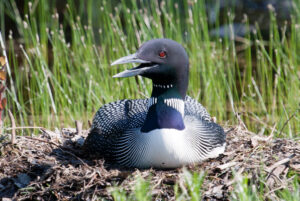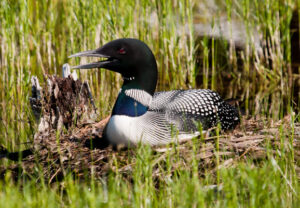Loons
In the tranquil lakes and rivers of Maine, the haunting call of the loon echoes through the mist, captivating the hearts of all who hear it. Identifying these majestic birds is a delight, with their striking black-and-white plumage, red eyes, and distinctive silhouette gliding gracefully across the water. Their presence is not only a testament to the pristine wilderness of Maine but also a reminder of the vital role they play in the environment.
Loons are important indicators of the health of freshwater ecosystems in Maine and beyond. As top predators, they help regulate fish populations, contributing to the balance of aquatic ecosystems. Furthermore, their presence serves as a barometer for water quality, as they are sensitive to pollution and habitat degradation. Protecting loon habitats is not only crucial for their survival but also for the well-being of the entire ecosystem.

Moreover, loons hold cultural significance for the people of Maine, serving as symbols of wilderness and tranquility. Their haunting calls and graceful movements have inspired artists, writers, and nature enthusiasts for generations. Preserving their habitat and ensuring their continued presence in Maine’s lakes and rivers is essential for maintaining the region’s rich biodiversity and natural heritage.
In conclusion, loons in Maine are not just iconic birds; they are vital contributors to the health and beauty of the state’s natural landscapes. Their presence serves as a reminder of the interconnectedness of all living things and the importance of preserving the delicate balance of ecosystems. By appreciating and protecting loons and their habitats, we can ensure that future generations will continue to be enchanted by their haunting calls and graceful presence in Maine’s pristine wilderness.
